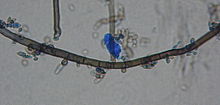- Aureobasidium pullulans
-
Aureobasidium pullulans 
Scientific classification Kingdom: Fungi Phylum: Ascomycota Class: Dothideomycetes Subclass: Dothideomycetidae Order: Dothideales Family: Dothioraceae Genus: Aureobasidium Species: A. pullulans Binomial name Aureobasidium pullulans Synonyms Aureobasidium oleae
Aureobasidium pullulans
Azymocandida malicola
Candida malicola
Cladosporium pullulans
Dematium pullulans
Exobasidium vitis
Hormonema oleae
Hormonema pullulans
Pullularia fermentans
Pullularia fermentans var. schoenii
Pullularia pullulans
Torula oleae
Torula schoeniiAureobasidium pullulans is a ubiquitous yeast-like fungus that can be found in different environments (e.g. soil, water, air and limestone). It is well known as a naturally occurring epiphyte or endophyte of a wide range of plant species (e.g. apple, grape, cucumber, green beans, cabbage) without causing any symptoms of disease. A. pullulans has a high importance in biotechnology for the production of different enzymes, siderophores and pullulan. Furthermore A. pullulans is used in biological control of plant diseases, especially storage diseases. In addition to the beneficial aspects, A. pullulans is in a few cases associated with plant disease (e.g. stigmatomycosis on cotton). It can be cultivated on potato dextrose agar where it produces smooth, faint pink yeast-like colonies that are covered with a slimy mass of spores. Older colonies change to black due to chlamydospore production. Primary conidia are hyaline, smooth, ellipsoidal, one-celled, and variable in shape and size; secondary conidia are smaller. Conidiophores are undifferentiated, intercalary or terminal, or arising as short lateral branches. Endoconidia are produced in an intercalary cell and released into a neighboring empty cell. Hyphae are hyaline, smooth, thinwalled, with transverse septa. The fungus grows at 10–35 °C with optimum growth at 30 °C.
Chronic human exposure via humidifiers or air conditioners can lead to hypersensitivity pneumonitis (aka extrinsic allergic alveolitis) or "humidifier lung". This condition is characterized acutely by dyspnea, cough, fever, chest infiltrates, and acute inflammatory reaction. Condition can also be chronic, and lymphocyte mediated. Chronic condition is characterized radiographically by reticulonodular infiltrates in the lung, with apical sparing.
A. pullulans is notable for its phenotypic plasticity. Colony morphology may be affected by carbon source, colony age, temperature, light and substrate, with colonies ranging from homogeneous to sectored, yeast-like to filamentous growth, and from small to large. These changes, potentially influenced by epigenetic factors, and the particular developmental sequences that the colonies proceed through may be observed with the naked eye.
References
- Themis J. Michailides. ""Above ground fungal diseases", Chapter 27.". http://fruitsandnuts.ucdavis.edu/crops/papers/Chapter_27.pdf.
- Chi, Z., Wang, F., Chi, Z., Yue, L., Lui, G. and Zhang, T., 2009. Bioproducts from Aureobasidium pulluulans, a biotechnologically important yeast. Appl. Microbiol. Biotechnol. 82:793-804.
- Fleet, G.H., 2003. Yeast interactions and wine flavour. Int. J. Food Microbiol. 86:11-22.
- Falconi, C.J. and Mendgen, K., 1994. Epiphytic fungi on apple leaves and their value for control of the postharvest pathogens Botrytis cinerea, Monilinia fructigena and Penicillium expansum. Z.PflKrankh. PflSchutz 101:38-47.
- Andrews, J.H., Spear, R.N. and Nordheim, E.V., 2002. Population biology of Aureobasidium pullulans on apple leaf surfaces. Can. J. Microbiol. 48:500-513.
- Webb, T.A. and Mundt, J.O., 1978. Molds on vegetables at the time of harvest. Appl. Environ. Microbiol. 35:655-658.
- Simon, L., Caye-Vaugien, C. and Bouchonneau, M., 1993. Relation between pullulan production, morphological state and growth conditions in Aureobasidium pullulans: new observations. Journal of General Microbiology 139:979-985.
- Slepecky, R. A., & Starmer, W. T. 2009. "Phenotypic plasticity in fungi: a review with observations on Aureobasidium pullulans.". http://www.mycologia.org/cgi/content/abstract/101/6/823. Mycologia, 101, 6, 823-832.
External links
- Index Fungorum
- USDA ARS Fungal Database
- List of plant species associated with A. pullulans without any symptoms of disease
Categories:- Yeasts
- Dothideomycetes
- Dothideomycetes stubs
- Plant disease stubs
Wikimedia Foundation. 2010.
